Control Systems Signals and Systems Review
VerifiedAdded on 2023/04/25
|8
|1305
|66
AI Summary
This document reviews signals and systems in control systems, including Laplace transform, bode diagram, and discrete time systems. It also covers least squares solutions in control systems.
Contribute Materials
Your contribution can guide someone’s learning journey. Share your
documents today.
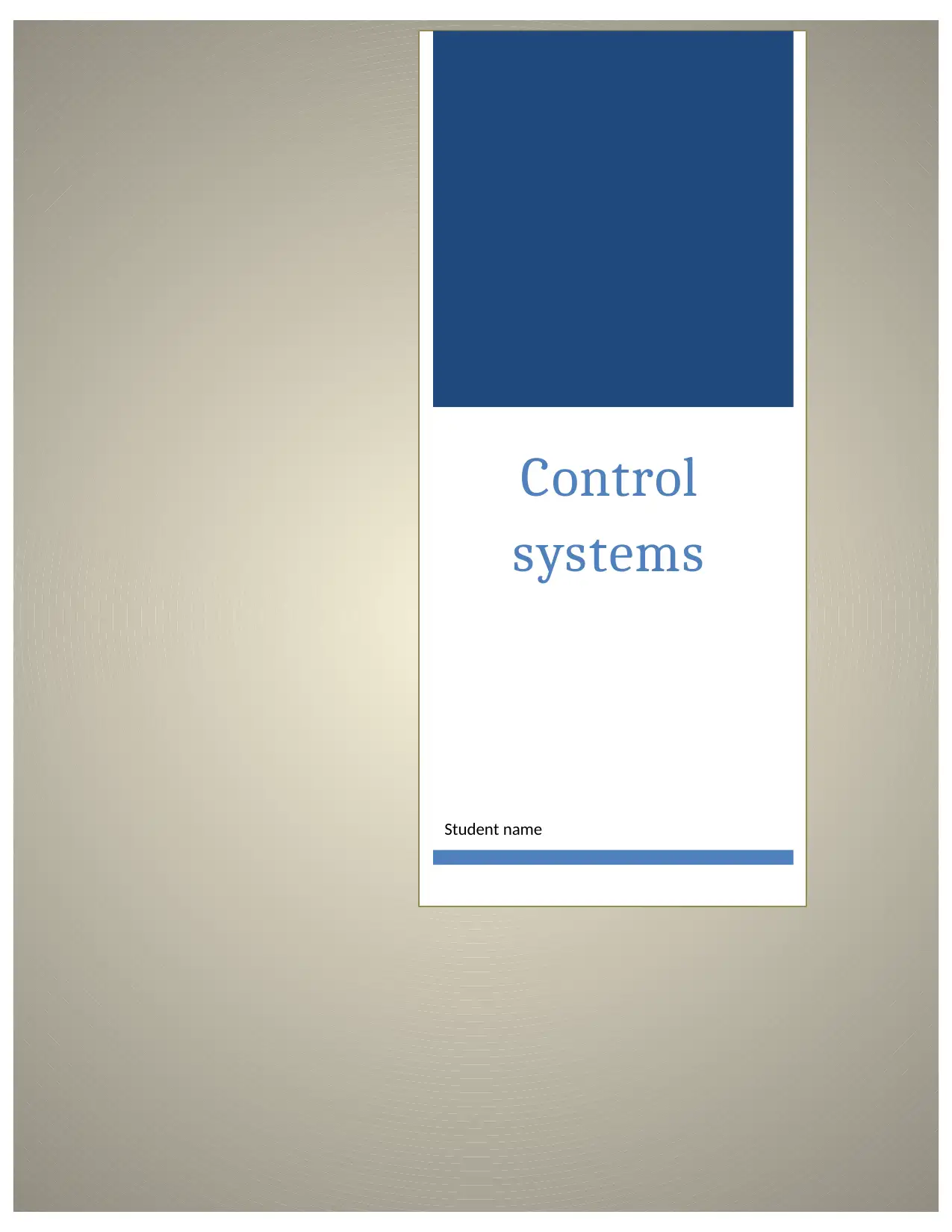
Control
systems
Student name
systems
Student name
Secure Best Marks with AI Grader
Need help grading? Try our AI Grader for instant feedback on your assignments.
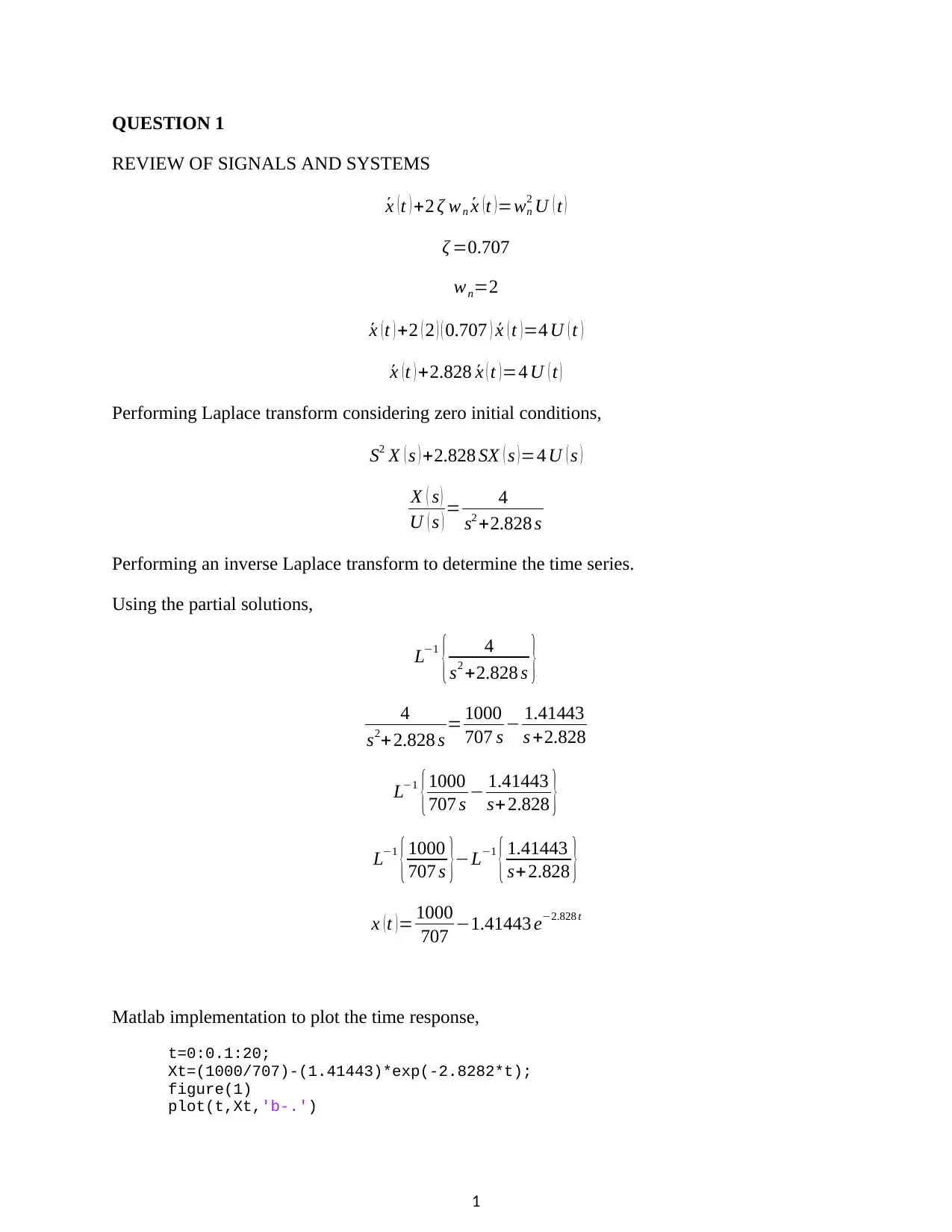
QUESTION 1
REVIEW OF SIGNALS AND SYSTEMS
´x (t ) +2 ζ wn ´x (t )=wn
2 U ( t )
ζ =0.707
wn=2
´x (t ) +2 ( 2 ) ( 0.707 ) ´x ( t )=4 U ( t )
´x ( t ) +2.828 ´x ( t ) =4 U ( t )
Performing Laplace transform considering zero initial conditions,
S2 X ( s ) +2.828 SX ( s )=4 U ( s )
X ( s )
U ( s ) = 4
s2 +2.828 s
Performing an inverse Laplace transform to determine the time series.
Using the partial solutions,
L−1
{ 4
s2 +2.828 s }
4
s2+ 2.828 s = 1000
707 s − 1.41443
s +2.828
L−1
{ 1000
707 s − 1.41443
s+ 2.828 }
L−1
{ 1000
707 s }−L−1
{ 1.41443
s+2.828 }
x (t )= 1000
707 −1.41443 e−2.828 t
Matlab implementation to plot the time response,
t=0:0.1:20;
Xt=(1000/707)-(1.41443)*exp(-2.8282*t);
figure(1)
plot(t,Xt,'b-.')
1
REVIEW OF SIGNALS AND SYSTEMS
´x (t ) +2 ζ wn ´x (t )=wn
2 U ( t )
ζ =0.707
wn=2
´x (t ) +2 ( 2 ) ( 0.707 ) ´x ( t )=4 U ( t )
´x ( t ) +2.828 ´x ( t ) =4 U ( t )
Performing Laplace transform considering zero initial conditions,
S2 X ( s ) +2.828 SX ( s )=4 U ( s )
X ( s )
U ( s ) = 4
s2 +2.828 s
Performing an inverse Laplace transform to determine the time series.
Using the partial solutions,
L−1
{ 4
s2 +2.828 s }
4
s2+ 2.828 s = 1000
707 s − 1.41443
s +2.828
L−1
{ 1000
707 s − 1.41443
s+ 2.828 }
L−1
{ 1000
707 s }−L−1
{ 1.41443
s+2.828 }
x (t )= 1000
707 −1.41443 e−2.828 t
Matlab implementation to plot the time response,
t=0:0.1:20;
Xt=(1000/707)-(1.41443)*exp(-2.8282*t);
figure(1)
plot(t,Xt,'b-.')
1
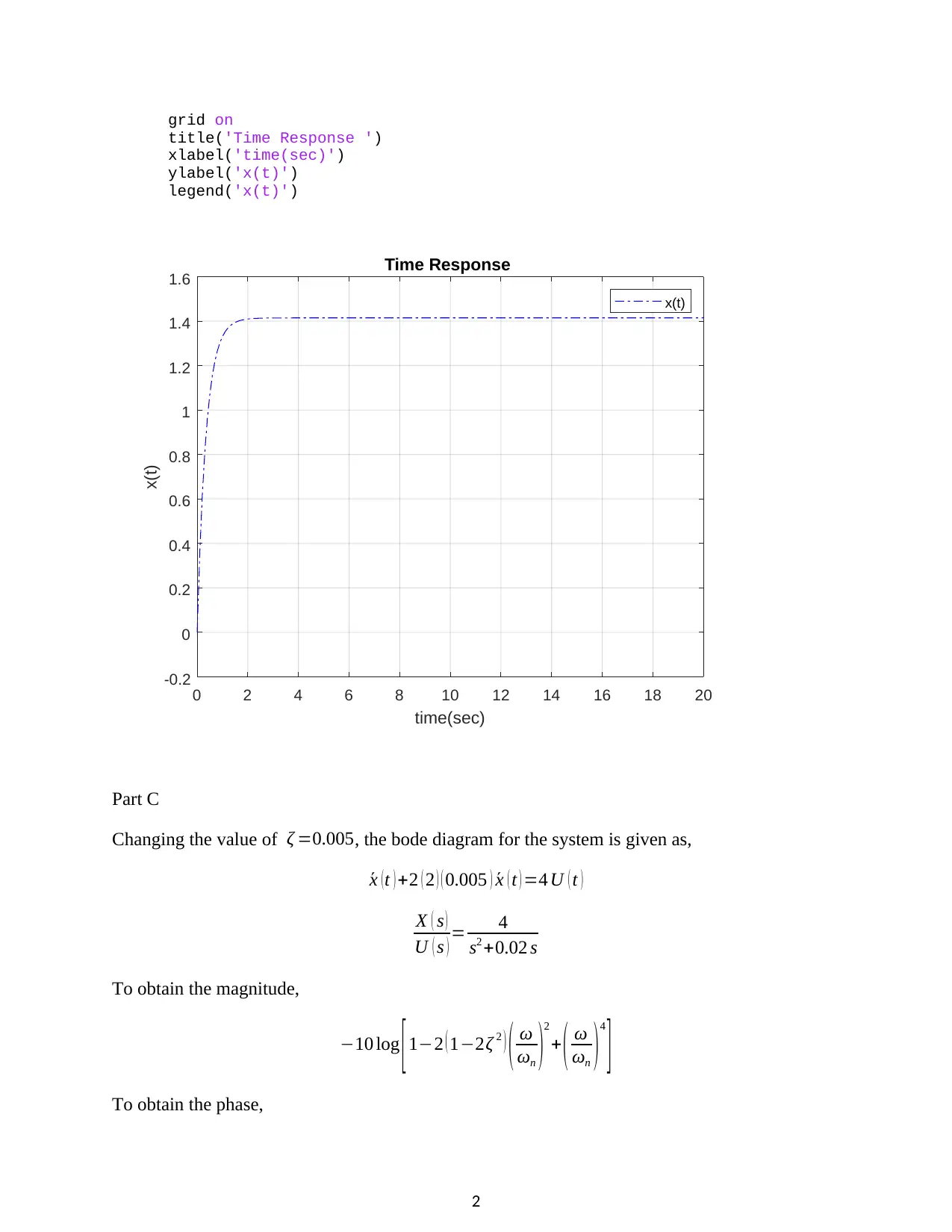
grid on
title('Time Response ')
xlabel('time(sec)')
ylabel('x(t)')
legend('x(t)')
0 2 4 6 8 10 12 14 16 18 20
time(sec)
-0.2
0
0.2
0.4
0.6
0.8
1
1.2
1.4
1.6
x(t)
Time Response
x(t)
Part C
Changing the value of ζ =0.005, the bode diagram for the system is given as,
´x ( t ) +2 ( 2 ) ( 0.005 ) ´x ( t ) =4 U ( t )
X ( s )
U ( s ) = 4
s2 +0.02 s
To obtain the magnitude,
−10 log [1−2 ( 1−2ζ 2 ) ( ω
ωn )2
+ ( ω
ωn )4
]
To obtain the phase,
2
title('Time Response ')
xlabel('time(sec)')
ylabel('x(t)')
legend('x(t)')
0 2 4 6 8 10 12 14 16 18 20
time(sec)
-0.2
0
0.2
0.4
0.6
0.8
1
1.2
1.4
1.6
x(t)
Time Response
x(t)
Part C
Changing the value of ζ =0.005, the bode diagram for the system is given as,
´x ( t ) +2 ( 2 ) ( 0.005 ) ´x ( t ) =4 U ( t )
X ( s )
U ( s ) = 4
s2 +0.02 s
To obtain the magnitude,
−10 log [1−2 ( 1−2ζ 2 ) ( ω
ωn )2
+ ( ω
ωn )4
]
To obtain the phase,
2
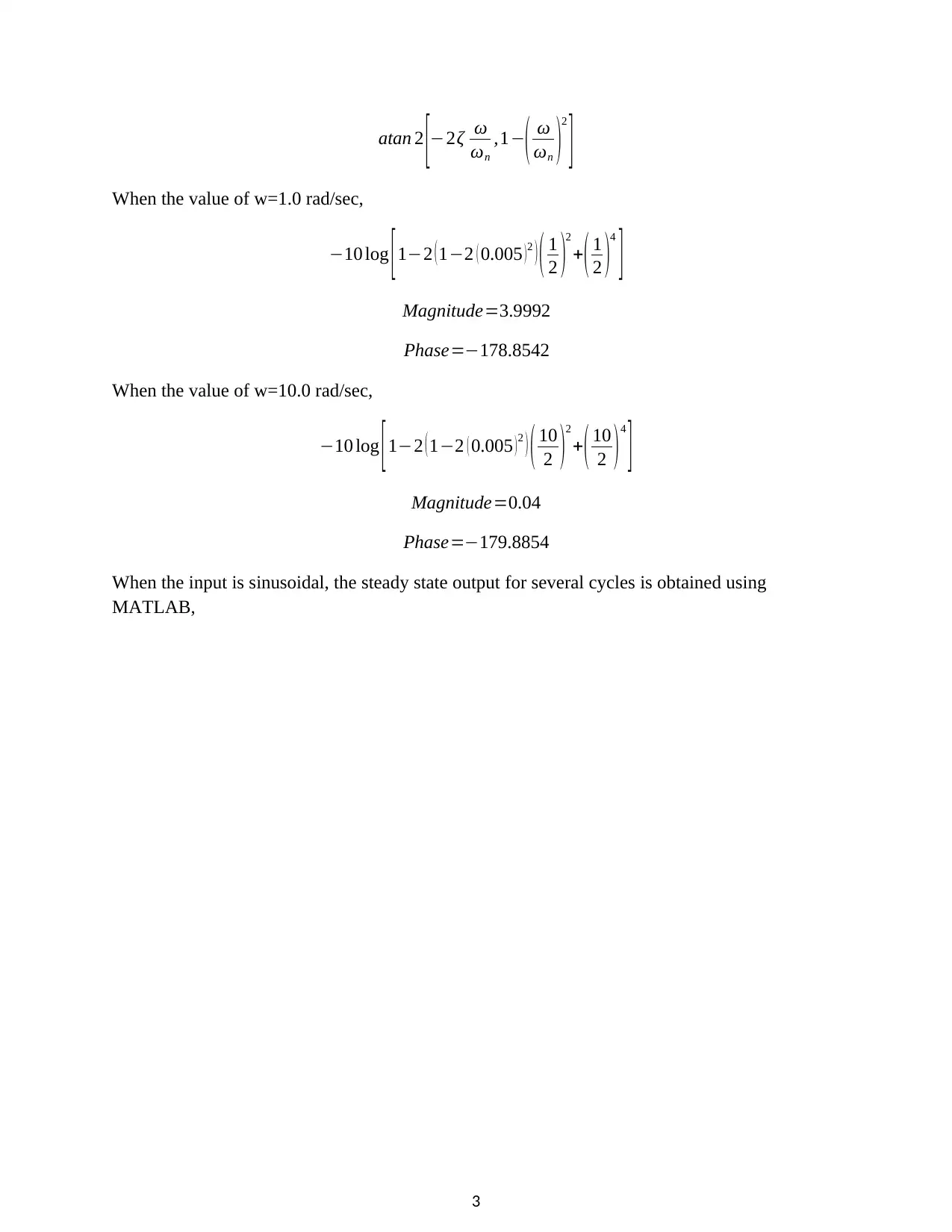
atan 2 [−2ζ ω
ωn
,1−
( ω
ωn )2
]
When the value of w=1.0 rad/sec,
−10 log [1−2 (1−2 ( 0.005 )2 ) ( 1
2 )2
+( 1
2 )4
]
Magnitude=3.9992
Phase=−178.8542
When the value of w=10.0 rad/sec,
−10 log [1−2 (1−2 ( 0.005 )2 ) ( 10
2 )2
+( 10
2 )4
]
Magnitude=0.04
Phase=−179.8854
When the input is sinusoidal, the steady state output for several cycles is obtained using
MATLAB,
3
ωn
,1−
( ω
ωn )2
]
When the value of w=1.0 rad/sec,
−10 log [1−2 (1−2 ( 0.005 )2 ) ( 1
2 )2
+( 1
2 )4
]
Magnitude=3.9992
Phase=−178.8542
When the value of w=10.0 rad/sec,
−10 log [1−2 (1−2 ( 0.005 )2 ) ( 10
2 )2
+( 10
2 )4
]
Magnitude=0.04
Phase=−179.8854
When the input is sinusoidal, the steady state output for several cycles is obtained using
MATLAB,
3
Secure Best Marks with AI Grader
Need help grading? Try our AI Grader for instant feedback on your assignments.
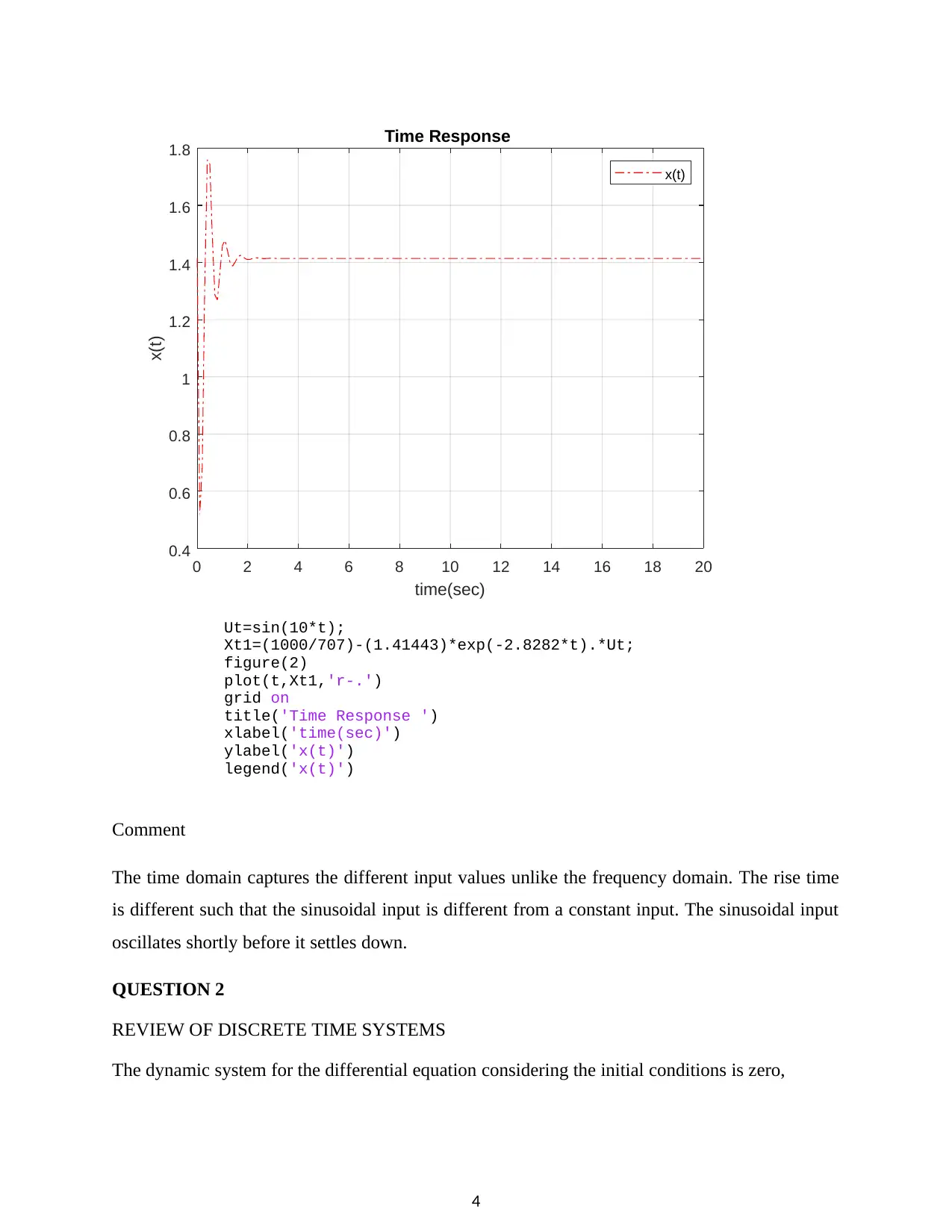
0 2 4 6 8 10 12 14 16 18 20
time(sec)
0.4
0.6
0.8
1
1.2
1.4
1.6
1.8
x(t)
Time Response
x(t)
Ut=sin(10*t);
Xt1=(1000/707)-(1.41443)*exp(-2.8282*t).*Ut;
figure(2)
plot(t,Xt1,'r-.')
grid on
title('Time Response ')
xlabel('time(sec)')
ylabel('x(t)')
legend('x(t)')
Comment
The time domain captures the different input values unlike the frequency domain. The rise time
is different such that the sinusoidal input is different from a constant input. The sinusoidal input
oscillates shortly before it settles down.
QUESTION 2
REVIEW OF DISCRETE TIME SYSTEMS
The dynamic system for the differential equation considering the initial conditions is zero,
4
time(sec)
0.4
0.6
0.8
1
1.2
1.4
1.6
1.8
x(t)
Time Response
x(t)
Ut=sin(10*t);
Xt1=(1000/707)-(1.41443)*exp(-2.8282*t).*Ut;
figure(2)
plot(t,Xt1,'r-.')
grid on
title('Time Response ')
xlabel('time(sec)')
ylabel('x(t)')
legend('x(t)')
Comment
The time domain captures the different input values unlike the frequency domain. The rise time
is different such that the sinusoidal input is different from a constant input. The sinusoidal input
oscillates shortly before it settles down.
QUESTION 2
REVIEW OF DISCRETE TIME SYSTEMS
The dynamic system for the differential equation considering the initial conditions is zero,
4
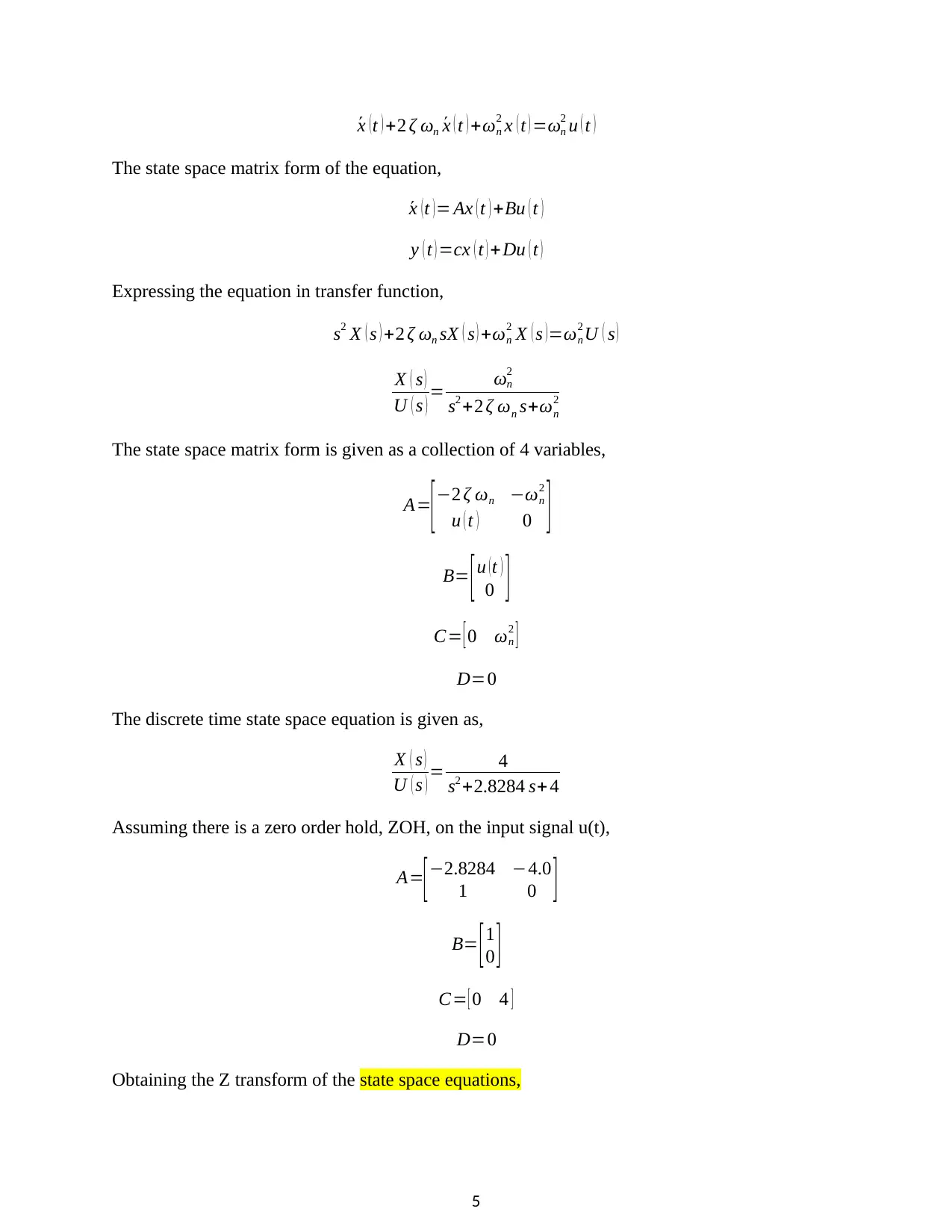
´x ( t ) +2 ζ ωn ´x ( t ) +ωn
2 x ( t ) =ωn
2 u ( t )
The state space matrix form of the equation,
´x ( t ) = Ax ( t ) +Bu ( t )
y ( t ) =cx ( t ) +Du ( t )
Expressing the equation in transfer function,
s2 X ( s ) +2 ζ ωn sX ( s ) +ωn
2 X ( s ) =ωn
2 U ( s )
X ( s )
U ( s ) = ωn
2
s2 +2 ζ ωn s+ωn
2
The state space matrix form is given as a collection of 4 variables,
A=
[−2 ζ ωn −ωn
2
u ( t ) 0 ]
B= [u (t )
0 ]
C= [ 0 ωn
2 ]
D=0
The discrete time state space equation is given as,
X ( s )
U ( s ) = 4
s2 +2.8284 s+ 4
Assuming there is a zero order hold, ZOH, on the input signal u(t),
A=
[ −2.8284 −4.0
1 0 ]
B= [1
0 ]
C= [ 0 4 ]
D=0
Obtaining the Z transform of the state space equations,
5
2 x ( t ) =ωn
2 u ( t )
The state space matrix form of the equation,
´x ( t ) = Ax ( t ) +Bu ( t )
y ( t ) =cx ( t ) +Du ( t )
Expressing the equation in transfer function,
s2 X ( s ) +2 ζ ωn sX ( s ) +ωn
2 X ( s ) =ωn
2 U ( s )
X ( s )
U ( s ) = ωn
2
s2 +2 ζ ωn s+ωn
2
The state space matrix form is given as a collection of 4 variables,
A=
[−2 ζ ωn −ωn
2
u ( t ) 0 ]
B= [u (t )
0 ]
C= [ 0 ωn
2 ]
D=0
The discrete time state space equation is given as,
X ( s )
U ( s ) = 4
s2 +2.8284 s+ 4
Assuming there is a zero order hold, ZOH, on the input signal u(t),
A=
[ −2.8284 −4.0
1 0 ]
B= [1
0 ]
C= [ 0 4 ]
D=0
Obtaining the Z transform of the state space equations,
5
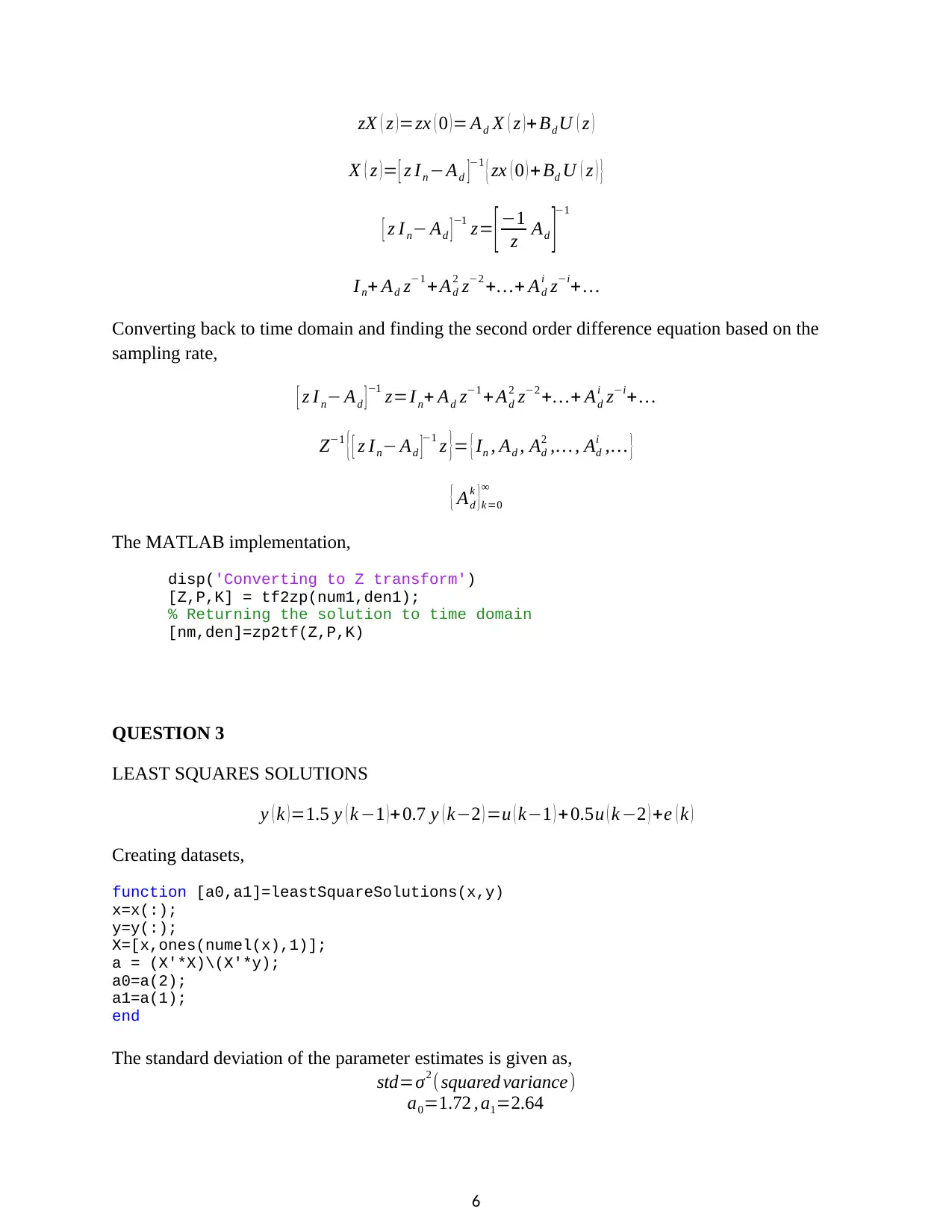
zX ( z ) =zx ( 0 ) = Ad X ( z ) + Bd U ( z )
X ( z )= [ z In −Ad ]−1
{ zx ( 0 ) + Bd U ( z ) }
[ z I n− Ad ] −1 z= [ −1
z Ad ]
−1
I n+ Ad z−1 +Ad
2 z−2 +…+ Ad
i z−i+ …
Converting back to time domain and finding the second order difference equation based on the
sampling rate,
[ z I n− Ad ] −1 z=I n+ Ad z−1 + Ad
2 z−2 +…+ Ad
i z−i+…
Z−1
{ [ z In− Ad ]−1 z }= { In , Ad , Ad
2 ,… , Ad
i ,… }
{ Ad
k } k=0
∞
The MATLAB implementation,
disp('Converting to Z transform')
[Z,P,K] = tf2zp(num1,den1);
% Returning the solution to time domain
[nm,den]=zp2tf(Z,P,K)
QUESTION 3
LEAST SQUARES SOLUTIONS
y ( k )=1.5 y ( k −1 )+0.7 y ( k−2 ) =u ( k−1 ) +0.5u ( k −2 ) +e ( k )
Creating datasets,
function [a0,a1]=leastSquareSolutions(x,y)
x=x(:);
y=y(:);
X=[x,ones(numel(x),1)];
a = (X'*X)\(X'*y);
a0=a(2);
a1=a(1);
end
The standard deviation of the parameter estimates is given as,
std=σ2 ( squared variance)
a0=1.72 , a1=2.64
6
X ( z )= [ z In −Ad ]−1
{ zx ( 0 ) + Bd U ( z ) }
[ z I n− Ad ] −1 z= [ −1
z Ad ]
−1
I n+ Ad z−1 +Ad
2 z−2 +…+ Ad
i z−i+ …
Converting back to time domain and finding the second order difference equation based on the
sampling rate,
[ z I n− Ad ] −1 z=I n+ Ad z−1 + Ad
2 z−2 +…+ Ad
i z−i+…
Z−1
{ [ z In− Ad ]−1 z }= { In , Ad , Ad
2 ,… , Ad
i ,… }
{ Ad
k } k=0
∞
The MATLAB implementation,
disp('Converting to Z transform')
[Z,P,K] = tf2zp(num1,den1);
% Returning the solution to time domain
[nm,den]=zp2tf(Z,P,K)
QUESTION 3
LEAST SQUARES SOLUTIONS
y ( k )=1.5 y ( k −1 )+0.7 y ( k−2 ) =u ( k−1 ) +0.5u ( k −2 ) +e ( k )
Creating datasets,
function [a0,a1]=leastSquareSolutions(x,y)
x=x(:);
y=y(:);
X=[x,ones(numel(x),1)];
a = (X'*X)\(X'*y);
a0=a(2);
a1=a(1);
end
The standard deviation of the parameter estimates is given as,
std=σ2 ( squared variance)
a0=1.72 , a1=2.64
6
Paraphrase This Document
Need a fresh take? Get an instant paraphrase of this document with our AI Paraphraser
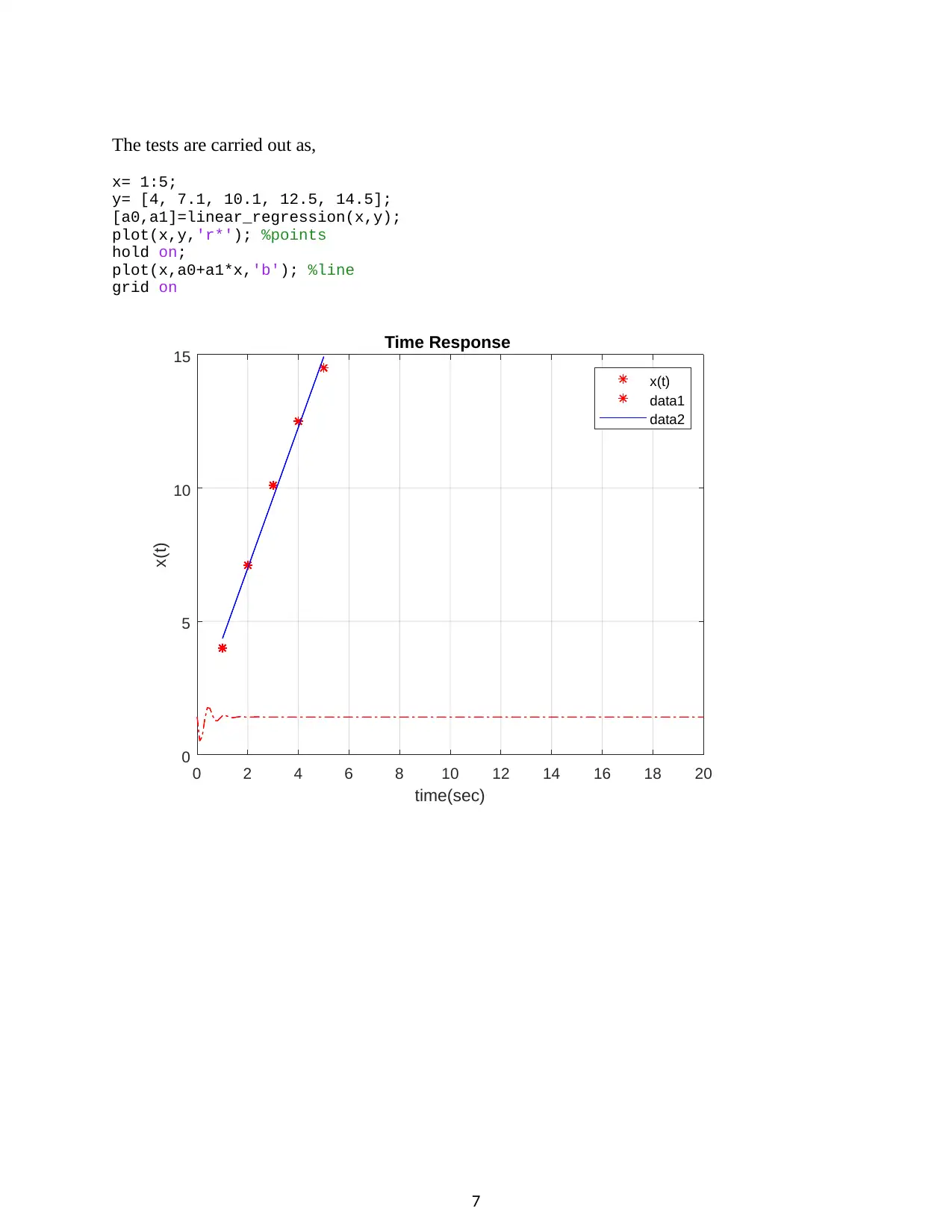
The tests are carried out as,
x= 1:5;
y= [4, 7.1, 10.1, 12.5, 14.5];
[a0,a1]=linear_regression(x,y);
plot(x,y,'r*'); %points
hold on;
plot(x,a0+a1*x,'b'); %line
grid on
0 2 4 6 8 10 12 14 16 18 20
time(sec)
0
5
10
15
x(t)
Time Response
x(t)
data1
data2
7
x= 1:5;
y= [4, 7.1, 10.1, 12.5, 14.5];
[a0,a1]=linear_regression(x,y);
plot(x,y,'r*'); %points
hold on;
plot(x,a0+a1*x,'b'); %line
grid on
0 2 4 6 8 10 12 14 16 18 20
time(sec)
0
5
10
15
x(t)
Time Response
x(t)
data1
data2
7
1 out of 8
Your All-in-One AI-Powered Toolkit for Academic Success.
+13062052269
info@desklib.com
Available 24*7 on WhatsApp / Email
![[object Object]](/_next/static/media/star-bottom.7253800d.svg)
Unlock your academic potential
© 2024 | Zucol Services PVT LTD | All rights reserved.

